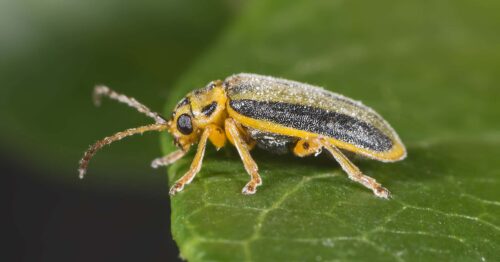Every tree owner fears the attack of the Elm Leaf Beetle. Stripping your tree of its leaves in just under a week, the Elm Leaf Beetle can quickly wreak havoc on a formerly healthy tree. Not only do these pests destroy the beautiful appearance of your tree, but they can stunt its growth and ultimately kill your tree.
How do you know if your tree is infested by the Elm Leaf Beetle and, more importantly, how do you get rid of them? The arborists at Jim’s Trees explain how to spot the signs of an infestation and how you can treat the pesky Elm Leaf Beetle.
Signs of an Elm Leaf Beetle infestation
To see if your Elm tree is infested by the Beetles, you will need to inspect the leaves of your tree. From March to September, the Elm Leaf Beetle is in winter hibernation so you will likely not spot the pests until they emerge in October. You can identify the Elm Leaf Beetle as being around 4 to 6mm in size, and having green and brown colouring with two stripes.
The Elm Leaf Beetle causes damage to the leaves of your tree both as an adult and as a larvae. Adult Beetles will create tiny holes in your leaves. The beetle larvae are yellow and dark brown in appearance, and tend to hatch from yellow eggs in December. The larvae will strip the leaves to the veins, giving your leaves a skeleton-like appearance. As they grow into adulthood, the Beetles will hibernate before laying eggs on the underside of the leaves in November.
Treating the Elm Leaf Beetle
If you have unfortunately spotted the Elm Leaf Beetle in your tree, there’s a few different ways you can treat the infestation. Much like any tree disease or pest infestation, early treatment is essential.
Trunk or soil injection
Trunk or soil injection, also known as a ‘tree vaccination’, involves injecting the trunk or soil of your tree with insecticide which will spread through the tree and into the leaves. The Beetles are killed by eating a small portion of the leaf and then ingesting the chemical. You will likely see the dead Beetles around the tree and soil. This is a relatively safe and more environmentally safe treatment, but ensure to seal the area to prevent pathogen entry.
Canopy spraying
The treatment of canopy spray means to apply Foliar spray to the canopy and leaves of your infected tree. This treatment is best suited to younger trees with smaller canopies and should be applied around full leaf expansion (usually late October).
Tree removal
In the case of a tree which is dying (or has died) due to repeated infestations, the best course of action is to remove it entirely. To guarantee safe and effective removal of the tree, it’s best to use a professional tree removal service. The experts will carefully remove the infested tree and responsibly dispose of it to prevent the spread of the Elm Leaf Beetle to your other trees.
Ask the experts for more advice on the Elm Leaf Beetle
If you require more advice on how to identify and treat the Elm Leaf Beetle, or need the professionals to successfully remove your tree then get in touch with the team at Jim’s Trees. As professional arborists, we can provide you with our expert opinions and perform any necessary services.

